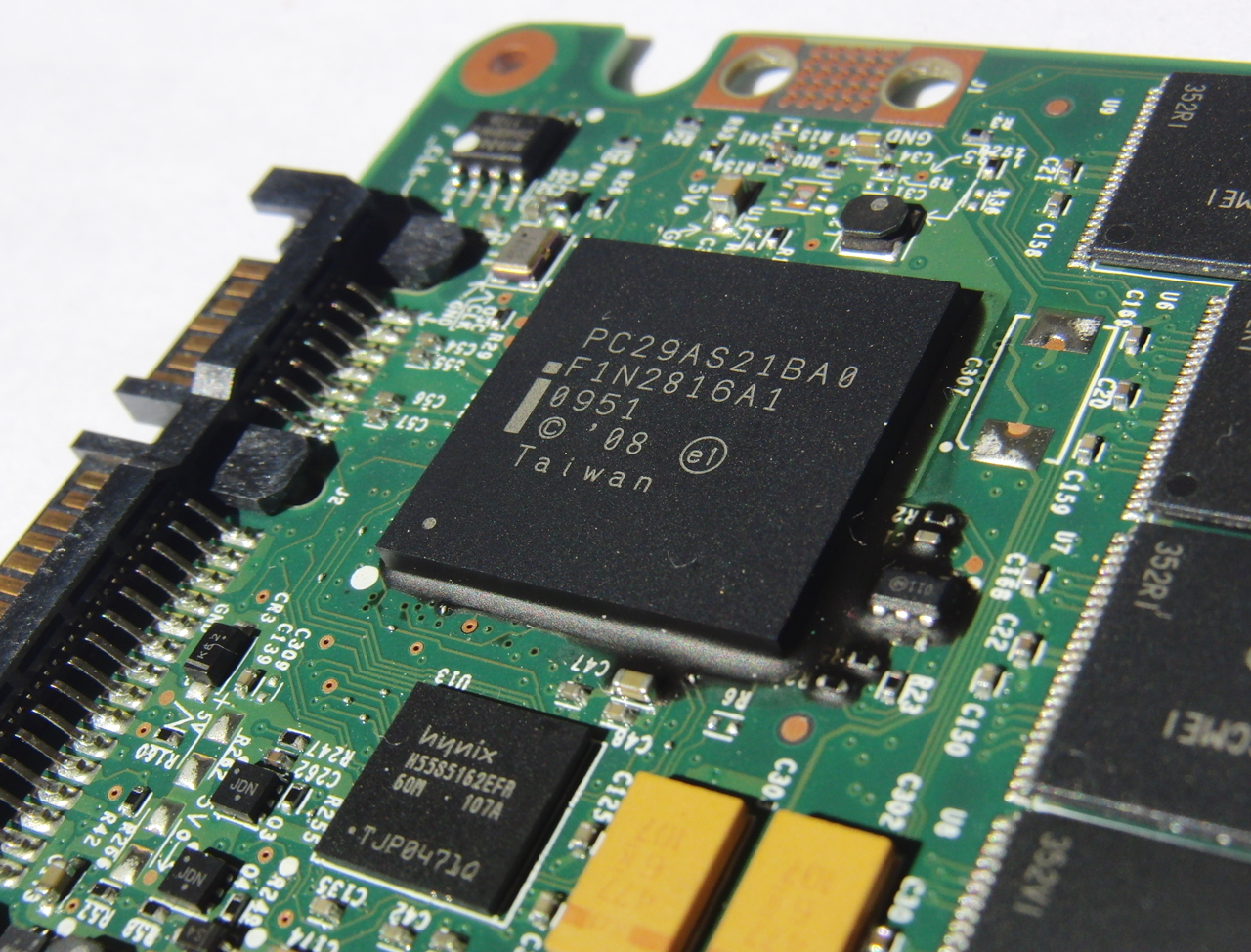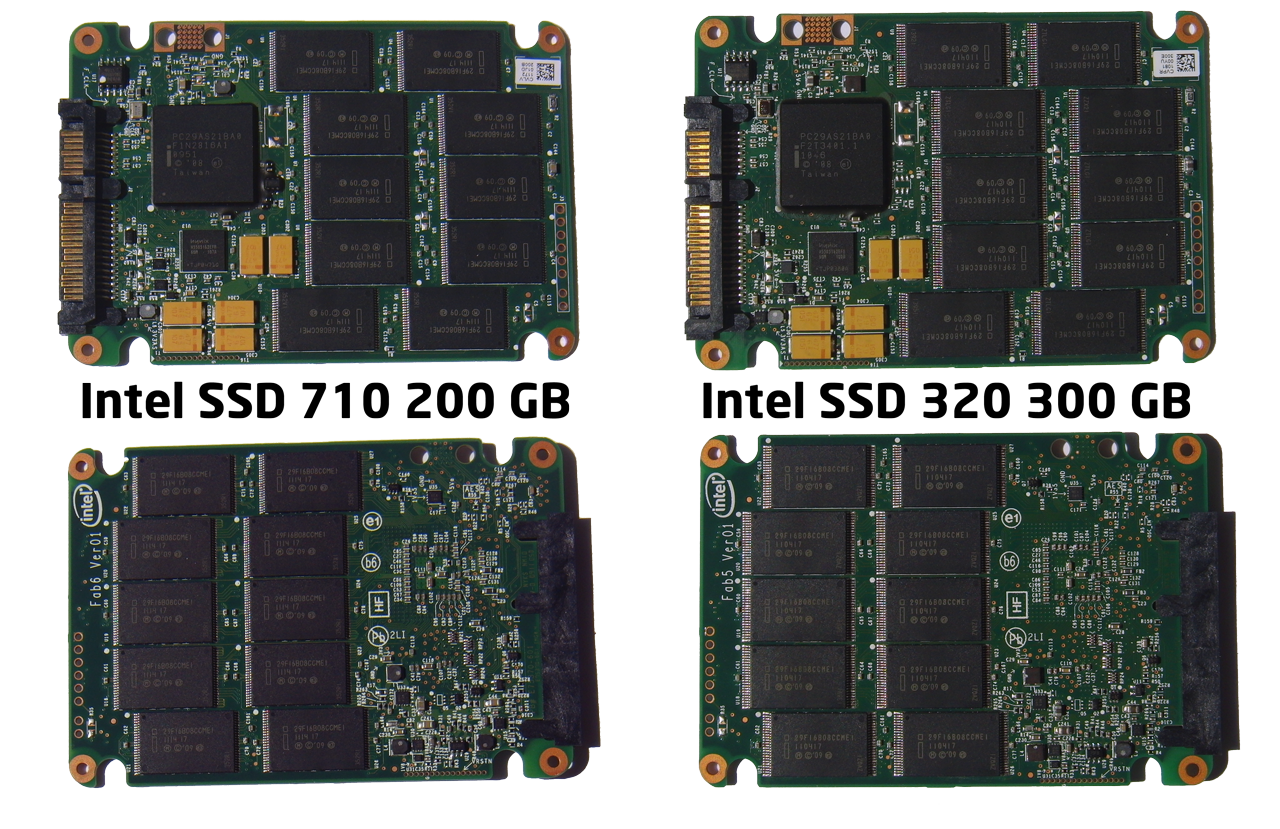Intel SSD 710 Tested: MLC NAND Flash Hits The Enterprise
Take note, enterprise customers: the successor to Intel's vaunted X25-E is here, and it doesn't center on SLC flash. Instead, the company is turning toward High Endurance Technology MLC. We dig deep to find out what this means for speed and reliability.
Inside The SSD 710: Something Old And Something New
Although this is technically a brand new SSD family, everything under the SSD 710's hood is pretty darned familiar. In fact, this enterprise-oriented drive is a mirror image of the consumer-oriented SSD 320. Both employ a ten-channel architecture based on Intel's PC29AS21BA0 controller. The difference, of course, is that the 710 SSD uses HET MLC, which is responsible for a scaled-back write speed rating. Beyond the controller and NAND, the SSD 320 and 710 share the ability to apply AES-128 encryption and protect data during power outages through the use of on-board capacitors.
| Header Cell - Column 0 | Intel SSD 320 (G3) | Intel SSD 710 |
|---|---|---|
| Capacities | 120/160/300/600 GB | 100/200/300 GB |
| NAND | IMFT 25 nm MLC, ONFI 2.2 | IMFT 25 nm HET MLC, ONFI 2.2 |
| Cache | 64 MB DRAM, 166 MHz | 64 MB DRAM, 166 MHz |
| Sequential Read | 270 MB/s | 270 MB/s |
| Sequential Write | 220 MB/s | 210 MB/s |
| 4 KB Random Read | 39 500 IOPS | 38 500 IOPS |
| 4 KB Random Write | 23 000 IOPS | 2700 IOPS |
| Security | ATA Password + AES-128 | ATA Password + AES-128 |
Put a 300 GB SSD 320 and a 200 GB SSD 710 next to each other; it's difficult to distinguish one from the other.
| Header Cell - Column 0 | Intel SSD 710200 GB | Intel SSD 320300 GB |
|---|---|---|
| Market Price (Debut) | $1299 | $549 |
| Price Per GB | $6.50 | $1.83 |
| Raw Flash | 320 GB | 320 GB |
| IDEMA Capacity | 200 GB | 300 GB |
| User Accessible | 186.31 GiB | 279.46 GiB |
| Over-Provisioning | 40% | 6.66% |
Like the 300 GB SSD 320 in our lab, Intel's 200 GB SSD 710 has 20 NAND packages, each one adding 16 GB to the drive's capacity. But while each SSD's PCB is aesthetically identical, the company's enterprise offering employs 40% over-provisioning. That's the highest we've seen from any product. This is a critical component in the adoption of MLC in the enterprise space, though, as increasing over-provisioning decreases write amplification, which in turn positively impacts the drive's endurance.
While 40% sounds like a lot, Intel recommends even more over-provisioning for write-heavy applications. If it were to set aside an additional 20% of the drive's NAND flash, write endurance would increase by another 50% or so. Combining HET MLC and exorbitant amounts of over-provisioning allows the SSD 710 to achieve an endurance rating 33x higher than the consumer-flavored SSD 320.
| Write Endurance(20% Extra Over-Provisioning In Parentheses) | NAND | Capacity Point | Endurance Rating |
|---|---|---|---|
| Intel SSD 320 | MLC | 160 GB300 GB600 GB | 15 TB30 TB60 TB |
| Intel SSD 710 | HET MLC | 100 GB200 GB300 GB | 500 TB (900 TB)1.0 PB (1.5 PB)1.1 PB (1.5 PB) |
Although there's one formula you can use to calculate the endurance of enterprise- and consumer-oriented SSDs, both classes employ different specifications. After all of the available P/E cycles are consumed, NAND cells on a consumer SSD (like the 320) retain data for 12 months. On enterprise-oriented SSDs (like the 710), it's only possible to retrieve data for three months, which is perfectly fine. In the world of enterprise storage, swapping out a defective drive occurs within hours, so a lengthy data retention window is unnecessary.
| Application | Active Use(Power On) | Data Retention(Power Off) | Functional FailureRequirement (FFR) | Uncorrectable Bit Error Rate |
|---|---|---|---|---|
| Client | 40oC8 hrs/day | 30oC 1 Year | ≤ 3% | ≤ 10-15 |
| Enterprise | 55oC 24 hrs/day | 30oC 3 Months | ≤ 3% | ≤ 10-16 |
Get Tom's Hardware's best news and in-depth reviews, straight to your inbox.
Current page: Inside The SSD 710: Something Old And Something New
Prev Page Intel On Enterprise Storage: No More SLC; Meet HET MLC Next Page HET MLC: Supercharged MLC Or SLC Lite?-
whysobluepandabear TLDR; Although expensive, the drives offer greater amounts of data transfer, reliability and expected life - however, they cost a f'ing arm and a leg (even for a corporation).Reply
Expect these to be the standard when they've dropped to 1/3rd their current price. -
RazorBurn To some companies or institutions.. The data this devices hold far outweighs the prices of this storage devices..Reply -
nekromobo I think the writer missed the whole point on this article.Reply
What happens when you RAID5 or RAID1 the SSD's??
I don't think any enterprise would trust a single SSD without RAID. -
halcyon __-_-_-__with the reliability those have they will never ever find their way into any serverMy Vertex 3 has been very reliable and I'm quite satisfied with the performance. However, I've heard reports that some, just like with anything else, haven't been so lucky.Reply -
toms my babys daddy I thought ssd drives were unreliable because they can die at any moment and lose your data, and now I see that they're used for servers as well? are they doing daily backups of their data or have I been lied to? ;(Reply -
halcyon toms my babys daddyI thought ssd drives were unreliable because they can die at any moment and lose your data, and now I see that they're used for servers as well? are they doing daily backups of their data or have I been lied to? ;(SSDs are generally accepted to be more reliable than HDDs...at least that's what I've been lead to believe.Reply -
Onus halcyonSSDs are generally accepted to be more reliable than HDDs...at least that's what I've been lead to believe.Yes, but when they die, that's it; you're done. You can at least send a mechanical HDD to Ontrack (or a competing data recovery service) with a GOOD chance of getting most or all of your data back; when a SSD bricks, what can be done?Reply
-
CaedenV nekromoboI think the writer missed the whole point on this article.What happens when you RAID5 or RAID1 the SSD's??I don't think any enterprise would trust a single SSD without RAID.The assumption is that ALL servers will have raid. The point of this article is how often will you have to replace the drives in your raid? All of that down time, and manpower has a price. If the old Intel SSDs were about as reliable as a traditional HDD, then that means that these new ones will last ~30x what a traidional drive does, while providing that glorious 0ms seek time, and high IO output.Reply
Less replacement, less down time, less $/GB, and a similar performance is a big win in my book.
toms my babys daddyI thought ssd drives were unreliable because they can die at any moment and lose your data, and now I see that they're used for servers as well? are they doing daily backups of their data or have I been lied to? ;(SSDs (at least on the enterprise level) are roughly equivalent to their mechanical brothers in failure rate. True, when the drive is done then the data is gone, but real data centers all use RAID, and backups for redundancy. Some go so far as to have all data being mirrored at 2 locations in real time, which is an extreme measure, but worth it when your data is so important.
Besides, when a data center has to do a physical recovery of a HDD then they have already failed. The down time it takes to physically recover is unacceptable in many data centers. Though at least it is still an option.


